“System for Finding All Tennis Grips”
The Importance of Selecting Your Tennis Grip
The tennis grip is how you hold the tennis racquet in your hand and impacts every shot you hit in tennis. It is important to know the different grips and the strengths and weaknesses of each so you can determine which grip is best suited for your game. The grip is often not given much thought, which is a mistake.
The tennis grip you select influences how the racquet will tend to swing through the ball, along with the angle of the racquet face and the optimal contact point. Some grips have a natural tendency to swing more through the ball producing a faster and flatter hit ball. Other grips naturally swing low to high generating a ball hit with more spin. It is important to understand these factors when selecting the grip that will compliment your style of play the best.
Your tennis grip can greatly influence your effectiveness in regards to your style of play and before deciding on a grip you should think about the big picture of your game. How do you want to play the game? Do you want to be an all court attacking player like Roger Federer? Federer uses a forehand grip that rests between an Eastern and semi-Western which allows him to swing through the ball, be aggressive, and dictate play. Or is your style of play more similar to a grinder that wares down his opponents like Rafael Nadal? Nadal uses a grip that is close to a Western which allows him to generate extreme topspin, greater net clearance, and in turn consistency. If you have a definitive answer, great! If not that’s okay. It is important to consider these questions because your response will help guide you when selecting your grips.
Remember, no tennis grip is perfect and there is wiggle room when making a selection. Each grip has its strengths and weaknesses. However, some grips are better suited for particular styles of play. The important thing to consider is which grip will compliment your game the best.
A System for Grasping Tennis Grips
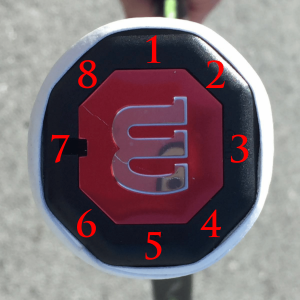
To find out which tennis grip you are utilizing and to learn how to grasp each grip there are a few tools and tips at your disposal. First, look at the handle of the grip, specifically the butt of the racquet. Notice the grip is an octagon, as it is divided into eight sides or bevels, with the bevels extending throughout the grip of the racquet. With the racquet face perpendicular to the court, making a 90 degree angle, let’s call the top bevel number one, and moving clockwise the next number two, and so on until we reach the final eighth bevel. By defining the bevels and understanding that they run throughout the racquet, it can be utilized as a system for finding each grip for your game later on.
Next, look at the palm of your hand, specifically at two points, the heel pad and the index knuckle. The heel pad is the padded fleshy portion of your hand that is right before your wrist and runs along the bone that connects to your pinky finger. The index knuckle is the padded portion of your palm that is right below your index finger, opposite of your index knuckle. Why is this important?
The tennis grips are technically defined by which bevel(s) of the grip your heel pad and index knuckle are resting on.
It is also important to realize that there is wiggle room when grasping each grip. For example, many players have slightly modified grips, such as a grip that rests in between an Eastern grip and a semi-Western grip. Modified grips occur over time as each player finds what grip is most comfortable and effective for each one of their strokes. With that in mind let’s get started!
Continental Tennis Grip
The Continental grip was traditionally the grip that was used for every tennis stroke back in the day, but that is no longer the case. The Continental grip is primarily used as the grip of choice for serves, volleys, and overheads. Many tennis players also utilize the Continental grip for hitting slices and hitting the two handed backhand with the dominant hand resting in the Continental.
Finding the Continental Tennis Grip
The Continental tennis grip can be found by placing your heel pad and index knuckle on bevel number two if you are right handed (Bevel number seven for lefties). Start by holding the throat of the racquet with your non dominant hand waist high and perpendicular to the ground, so that you are looking down at bevel number one. Then move clockwise to bevel number two, resting your heel pad and index knuckle onto bevel number two. For lefties, move counterclockwise one bevel and place your heel pad and index knuckle onto bevel number eight.
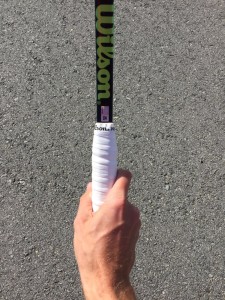 Pro Tip
Pro Tip
Many coaches state that a V is created by your thumb and forefinger on the top of the handle when holding the Continental Grip.
Strengths
- Low balls.
- Backspin.
Weaknesses
- High balls.
- Topspin.
What are your best practices for finding the Continental grip?
Eastern Forehand Tennis Grip
The Eastern forehand is a popular choice for attacking players today, such as Roger Federer, due to its versatility. The optimal contact point is waist high and out in front of the body. Due to the contact point, the Eastern forehand will naturally tend to swing more through the ball creating a relatively flat ball compared to other more extreme forehand grips. The Eastern forehand grip is a great option for players who are learning how to hit the forehand and also for players that are looking to attack due to being an easy transition to the Continental Grip.
Finding the Eastern Forehand Tennis Grip
The Eastern forehand can be found by placing your heel pad and index knuckle of the palm of your hand on bevel number three. Start by holding the throat of the racquet with your non-dominant hand waist high and perpendicular to the ground so you are looking down at bevel number one. Then move clockwise to bevel number three and place your heel pad and index knuckle onto bevel number three. For lefties, move counterclockwise to bevel number seven.
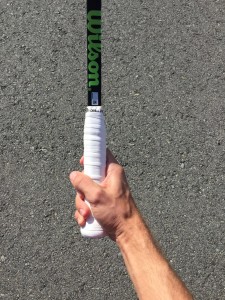 Pro Tip
Pro Tip
Often by doing any of these pro tips your hand will naturally find the Eastern grip.
- Hold the racquet the same way as mentioned above and shake hands with the grip of the racquet.
- Place your hand flat against the strings and slide it down to the grip.
Strengths
- Versatility between creating topspin and flattening out the ball.
- Transitions quickly to other grips.
Weaknesses
- Generating extreme topspin.
- Difficult to strike through balls beyond chest level.
- What are your thoughts on the Eastern Forehand grip and what would you add?
Semi-Western Forehand Tennis Grip
The semi-Western forehand tennis grip is the most popular grip among touring professionals today. Many players that have been labeled as power baseliners utilize the semi-Western grip. The contact point for the semi-Western is between waist and shoulder height and slightly further out in front of the body than the Eastern forehand. Due to the contact point, the semi-Western forehand will naturally swing low to high through the ball creating greater topspin when compared to the Eastern grip.
The semi-Western Forehand grip is a great option for tennis players of all styles. It can be used effectively on all surfaces, as seen today on the pro tour, and although the transition to the Continental Grip is greater than that of the Eastern Forehand Grip, overtime the transition becomes less noticeable.
Finding the Semi-Western Forehand Tennis Grip
To find the semi-Western, place your heel pad and index knuckle on bevel number four. Start by holding the throat of the racquet with your non dominant hand waist high and perpendicular to the ground so you are looking down at bevel number one. Then move clockwise to bevel number four, resting your heel pad and index knuckle on bevel number four. For lefties, move counterclockwise to bevel number six. When you find the semi-Western try spreading your fingers out to cover more surface area on the grip, you may find it more comfortable when gripping the racquet.
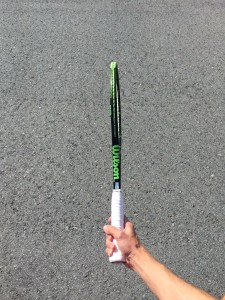 Pro Tip
Pro Tip
Place your racquet flat on a table or the ground and pick it up. This should naturally rest your hand near a Semi-Western.
Strengths
- Versatility between hitting flat and topspin balls.
- High balls.
- Short topspin angles.
Weaknesses
- The racquet face naturally closes and makes it difficult to pick up low balls that are commonly received from balls that are sliced or skidding off the court.
- Greater transition from the semi-Western grip to the Continental grip when coming up to net.
- What would you add to the semi-Western forehand grip that could benefit others?
Western Forehand Tennis Grip
The Western tennis grip is favored by clay-court specialists and players who want to wear down their opponent while hitting with extreme topspin. The contact point is around shoulder height. Due to the contact point, the Western forehand will naturally swing low to high through the ball at a greater trajectory creating greater topspin compared to other grip options.
The Western grip isn’t typically used by players that look to attack the net regularly due to the transition to the Continental Grip being sever. However, that doesn’t mean you can’t do it.
Finding the Western Forehand Tennis Grip
The full-Western tennis grip can be found by placing your heel pad and index knuckle of the palm of your hand on bevel number five. Start by holding the throat of the racquet with your non dominant hand waist high and perpendicular to the ground so you are looking down at bevel number one. Then move clockwise to bevel number five and place your heel pad and index knuckle onto bevel number five. For lefties, move counterclockwise to bevel number five as well. When you find the full-Western grip spread your fingers out to cover more surface area on the grip, you may find it more comfortable when gripping the racquet.
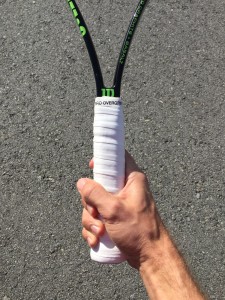 Pro Tip
Pro Tip
Hold the throat of the racquet with your non dominant hand waist high with the racquet face pointing toward the ground. Extend your dominant hand out waist high making a fist pump and with the same hand position grip the racquet handle to find the Western grip.
Strengths
- Extreme topspin.
- High balls.
- Higher net clearance.
Weaknesses
- Low balls.
- Can be difficult to flatten out shots.
- Requires tremendous racquet head speed and wrist strength.
- Significant transition to the continental grip when coming up to net.
- What are your thoughts on the Western forehand and what would you add to the conversation?
Eastern Backhand Tennis Grip
The Eastern backhand grip is the most popular grip amongst players who hit with a one handed backhand. The contact point for the Eastern backhand is waist high and out in front of the body. Due to the contact point, the Eastern backhand will naturally tend to swing more through the ball creating a relatively flat hit ball compared to balls hit with more extreme backhand grips.
The Eastern Backhand Grip is a great option for players of all ages and abilities who want to play all court tennis. The transition to the Continental Grip in minor when approaching the net.
Finding the Eastern Backhand Tennis Grip
The Eastern backhand grip can be found by placing your heel pad and index knuckle on bevel number one. An easy way to grip the racquet with the Eastern backhand grip is to hold the throat of the racquet straight out in front of you with your non dominate hand just below shoulder height, the strings perpendicular to the ground, and then place your dominant hand on the grip ensuring your wrist stays straight.
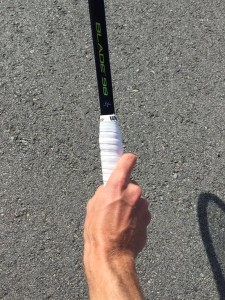 Pro Tip
Pro Tip
Find the Western forehand grip and simply turn your hand and racquet over to your backhand and you have the Eastern backhand grip.
Strengths
- Topspin and flat balls.
- Some players utilize the grip for the backhand slice as well.
- Easy transition to the continental grip when approaching the net.
Weaknesses
- High balls.
- How has your experience been with the Eastern backhand grip and what would you add for others to try?
Semi-Western Backhand Tennis Grip
The semi-Western backhand tennis grip is a popular choice among clay court players and has been utilized to produce some of the most powerful backhands in the game today. The semi-Western backhand grip is advanced and requires more upper body strength than the Eastern Backhand Grip.
The optimal contact point for the semi-Western backhand grip is higher and farther out in front of the body than the Eastern backhand grip. Due to the contact point, the semi-Western backhand will naturally swing low to high through the ball creating greater topspin compared to the Eastern backhand grip.
Finding the Semi-Western Backhand Tennis Grip
The semi-Western backhand grip can be found by resting your heel pad and index knuckle on bevel number eight. Start by holding the throat of the racquet with your non dominant hand waist high and perpendicular to the ground so you are looking down at bevel number one. Then move counterclockwise one bevel, to bevel number eight, and rest your heel pad and index knuckle onto bevel number eight. For lefties, move clockwise to bevel number two.
Pro Tip
Find the semi-Western forehand tennis grip and simply turn your hand and racquet over to your backhand and you have the semi-Western backhand grip.
Strengths
- High balls.
- Topspin.
Weaknesses
- Low balls.
- More significant of a grip change from the semi-Western to the Continental Grip than that of an Eastern grip when approaching the net.
- What professional tennis players today can you think of that utilize the semi-Western backhand grip?
Two-Handed Backhand Tennis Grip
The two-handed backhand tennis grip is extremely popular among professional players today. This grip is a good option for all players and a great option for players that lack the upper body strength to hit a one-handed backhand.
Many players have differences when it comes to how they hold the two-handed backhand grip. The important part is to hold the racquet in a way that allows for both arms to strike through the ball smoothly and that compliments your overall style of play.
Finding the Two-Handed Backhand Tennis Grip
Here are a couple of suggested ways to hold the two-handed backhand tennis grip. Place the dominant hand in the Continental Grip or the Eastern Backhand Grip, and the non-dominant hand in an Eastern Forehand Grip or the Semi-Western Forehand Grip.
There is debate about the ideal two-handed grip, but as we mentioned previously there is no perfect grip. However, the options above and anywhere in between will allow you to come up with the best fit for your game.
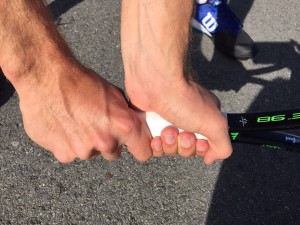 Pro Tip
Pro Tip
When grasping the racquet ensure there is no space between your dominant and non-dominant hand. The hands should be touching but not overlapping.
Strengths
- Topspin and flat balls.
- Can handle low balls and high balls below shoulder height.
Weaknesses
- Limits the player’s reach.
- More difficult to transition to the slice than the one handed backhand.
- What comes to mind when you think of the two-handed backhand grip?
That concludes our guide on tennis grips. We hope you enjoyed it and can take some tips to the court with you. You may also want to check out our article on how to measure your grip size and a complete list of guides on tennis technique.
Please take a moment to leave a comment or share this article with your friends on social media using the share links below. See you on the court!
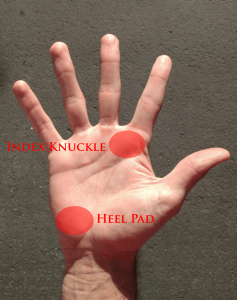



no discussion on where to place your hand with respect to the handle’s end! how far down the grip? on the flared end? just above? I’m looking for some guidance.
I recommend having heel pad of your hand near the flared end of the grip especially on volleys. Many professional players will have the heel pad off the grip for leverage to produce greater racquet head speed. However, I find having your heel pad near the end of the racquet grip works well. You could choke up further on the grip for more control on volleys. Hope this helps!